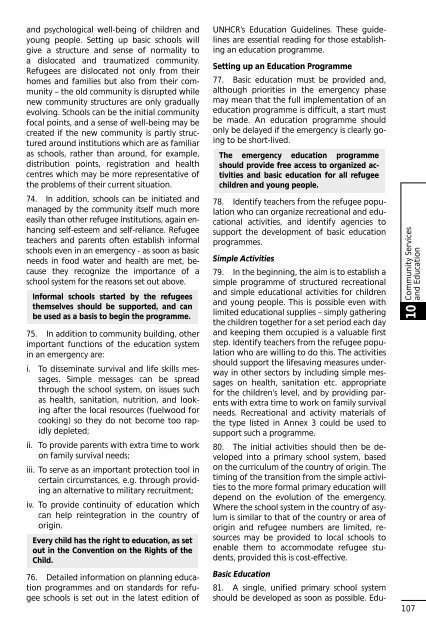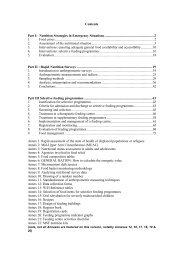UNHCR Handbook for Emergencies - UNHCR eCentre
UNHCR Handbook for Emergencies - UNHCR eCentre
UNHCR Handbook for Emergencies - UNHCR eCentre
You also want an ePaper? Increase the reach of your titles
YUMPU automatically turns print PDFs into web optimized ePapers that Google loves.
and psychological well-being of children and<br />
young people. Setting up basic schools will<br />
give a structure and sense of normality to<br />
a dislocated and traumatized community.<br />
Refugees are dislocated not only from their<br />
homes and families but also from their community<br />
– the old community is disrupted while<br />
new community structures are only gradually<br />
evolving. Schools can be the initial community<br />
focal points, and a sense of well-being may be<br />
created if the new community is partly structured<br />
around institutions which are as familiar<br />
as schools, rather than around, <strong>for</strong> example,<br />
distribution points, registration and health<br />
centres which may be more representative of<br />
the problems of their current situation.<br />
74. In addition, schools can be initiated and<br />
managed by the community itself much more<br />
easily than other refugee institutions, again enhancing<br />
self-esteem and self-reliance. Refugee<br />
teachers and parents often establish in<strong>for</strong>mal<br />
schools even in an emergency - as soon as basic<br />
needs in food water and health are met, because<br />
they recognize the importance of a<br />
school system <strong>for</strong> the reasons set out above.<br />
In<strong>for</strong>mal schools started by the refugees<br />
themselves should be supported, and can<br />
be used as a basis to begin the programme.<br />
75. In addition to community building, other<br />
important functions of the education system<br />
in an emergency are:<br />
i. To disseminate survival and life skills messages.<br />
Simple messages can be spread<br />
through the school system, on issues such<br />
as health, sanitation, nutrition, and looking<br />
after the local resources (fuelwood <strong>for</strong><br />
cooking) so they do not become too rapidly<br />
depleted;<br />
ii. To provide parents with extra time to work<br />
on family survival needs;<br />
iii. To serve as an important protection tool in<br />
certain circumstances, e.g. through providing<br />
an alternative to military recruitment;<br />
iv. To provide continuity of education which<br />
can help reintegration in the country of<br />
origin.<br />
Every child has the right to education, as set<br />
out in the Convention on the Rights of the<br />
Child.<br />
76. Detailed in<strong>for</strong>mation on planning education<br />
programmes and on standards <strong>for</strong> refugee<br />
schools is set out in the latest edition of<br />
<strong>UNHCR</strong>’s Education Guidelines. These guidelines<br />
are essential reading <strong>for</strong> those establishing<br />
an education programme.<br />
Setting up an Education Programme<br />
77. Basic education must be provided and,<br />
although priorities in the emergency phase<br />
may mean that the full implementation of an<br />
education programme is difficult, a start must<br />
be made. An education programme should<br />
only be delayed if the emergency is clearly going<br />
to be short-lived.<br />
The emergency education programme<br />
should provide free access to organized activities<br />
and basic education <strong>for</strong> all refugee<br />
children and young people.<br />
78. Identify teachers from the refugee population<br />
who can organize recreational and educational<br />
activities, and identify agencies to<br />
support the development of basic education<br />
programmes.<br />
Simple Activities<br />
79. In the beginning, the aim is to establish a<br />
simple programme of structured recreational<br />
and simple educational activities <strong>for</strong> children<br />
and young people. This is possible even with<br />
limited educational supplies – simply gathering<br />
the children together <strong>for</strong> a set period each day<br />
and keeping them occupied is a valuable first<br />
step. Identify teachers from the refugee population<br />
who are willing to do this. The activities<br />
should support the lifesaving measures underway<br />
in other sectors by including simple messages<br />
on health, sanitation etc. appropriate<br />
<strong>for</strong> the children’s level, and by providing parents<br />
with extra time to work on family survival<br />
needs. Recreational and activity materials of<br />
the type listed in Annex 3 could be used to<br />
support such a programme.<br />
80. The initial activities should then be developed<br />
into a primary school system, based<br />
on the curriculum of the country of origin. The<br />
timing of the transition from the simple activities<br />
to the more <strong>for</strong>mal primary education will<br />
depend on the evolution of the emergency.<br />
Where the school system in the country of asylum<br />
is similar to that of the country or area of<br />
origin and refugee numbers are limited, resources<br />
may be provided to local schools to<br />
enable them to accommodate refugee students,<br />
provided this is cost-effective.<br />
Basic Education<br />
81. A single, unified primary school system<br />
should be developed as soon as possible. Edu-<br />
Community Services<br />
and Education<br />
10<br />
107



